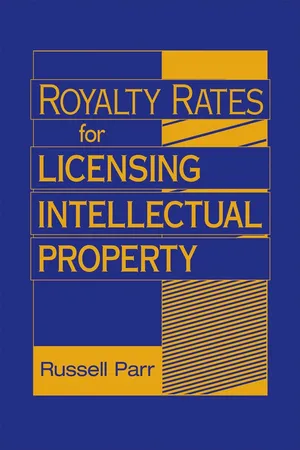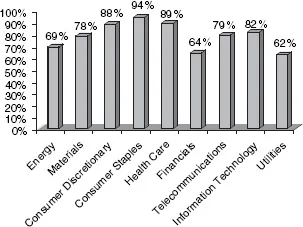
- English
- ePUB (mobile friendly)
- Available on iOS & Android
eBook - ePub
Royalty Rates for Licensing Intellectual Property
About this book
Royalty Rates for Licensing Intellectual Property includes critical information on financial theory, rules of thumb, industry guidelines, litigation based royalty rates, and tables of actual rates from real deals for different industries.
Frequently asked questions
Yes, you can cancel anytime from the Subscription tab in your account settings on the Perlego website. Your subscription will stay active until the end of your current billing period. Learn how to cancel your subscription.
No, books cannot be downloaded as external files, such as PDFs, for use outside of Perlego. However, you can download books within the Perlego app for offline reading on mobile or tablet. Learn more here.
Perlego offers two plans: Essential and Complete
- Essential is ideal for learners and professionals who enjoy exploring a wide range of subjects. Access the Essential Library with 800,000+ trusted titles and best-sellers across business, personal growth, and the humanities. Includes unlimited reading time and Standard Read Aloud voice.
- Complete: Perfect for advanced learners and researchers needing full, unrestricted access. Unlock 1.4M+ books across hundreds of subjects, including academic and specialized titles. The Complete Plan also includes advanced features like Premium Read Aloud and Research Assistant.
We are an online textbook subscription service, where you can get access to an entire online library for less than the price of a single book per month. With over 1 million books across 1000+ topics, we’ve got you covered! Learn more here.
Look out for the read-aloud symbol on your next book to see if you can listen to it. The read-aloud tool reads text aloud for you, highlighting the text as it is being read. You can pause it, speed it up and slow it down. Learn more here.
Yes! You can use the Perlego app on both iOS or Android devices to read anytime, anywhere — even offline. Perfect for commutes or when you’re on the go.
Please note we cannot support devices running on iOS 13 and Android 7 or earlier. Learn more about using the app.
Please note we cannot support devices running on iOS 13 and Android 7 or earlier. Learn more about using the app.
Yes, you can access Royalty Rates for Licensing Intellectual Property by Russell Parr in PDF and/or ePUB format, as well as other popular books in Law & Intellectual Property Law. We have over one million books available in our catalogue for you to explore.
Information
Chapter 1
Intellectual Property and Corporate Value
In the last thirty years, intellectual property (IP) and intangible assets have become the dominant assets of major corporations. These assets are at the heart of competitive advantage. They are the foundation of new product categories and sometimes entirely new industries. They differentiate products, provide unique utility, and even permeate products and services with cachet. Often, they allow the manufacturer to obtain a premium price for an otherwise ordinary item. Other times, they provide the user with substantial cost savings.
Ocean Tomo is an integrated, intellectual capital merchant bank.1 It conducted an analysis of the largest companies in the United States and found that patents, trademarks, copyrights, and other intangible assets have exploded as a percentage of the S&P 500’s market value, from seventeen percent in 1975 to eighty percent in 2005 (see Exhibit 1.1). No longer do markets value companies based on balance sheet cash and fixed assets. Today, stock prices reflect the importance and value of all intangible assets, including patents, trademarks, copyrights, and trade secrets.
EXHIBIT 1.1 S&P 500 COMPONENTS

This is supported by a recent Les Nouvelles article, where the value of IP and intangible assets, as a percentage of corporate market value, is reported as the exact same value shown by Standard and Poor’s index.2 The article shows that the dominance of intangibles is not solely associated with high technology companies, but rather holds true for a diverse selection of industries. For many industries, the dominance of IP is easy to understand. Healthcare, telecommunications, and consumer discretionary products would be expected to possess high amounts of technology or trademarks. Some industries, like utilities, would not be expected to have such intangible asset dominance, yet it turns out that all industries currently rely on a significant amount of IP and intangible assets (see Exhibit 1.2).3
EXHIBIT 1.2 Intangible Value as a % of Total Market Value for 2005

Thirty years ago, the vast majority of a company’s value was its monetary and tangible assets. These are the cash, inventories, accounts receivable, manufacturing facilities, warehouses, transportation systems, and office facilities of a company. Currently, these assets are almost an afterthought, replaced in importance by patented technology, trademarks, copyrights, and other intangible assets.
PATENTS
A patent for an invention is the grant of a property right to the inventor, issued by the United States Patent and Trademark Office (USPTO). Generally, the term of a new patent is twenty years from the date the application for the patent was filed in the United States or, in special cases, from the date an earlier related application was filed, subject to the payment of maintenance fees. U.S. patent grants are effective only within the United States, U.S. territories, and U.S. possessions. Under certain circumstances, patent term extensions or adjustments may be available.
The right conferred by the patent grant is, in the language of the statute and of the grant itself, “the right to exclude others from making, using, offering for sale, or selling” the invention in the United States, or “importing” the invention into the United States. What is granted is not the right to make, use, offer for sale, sell, or import, but the right to exclude others. Once a patent is issued, the patentee must enforce the patent without the aid of the USPTO.
There are three types of patents:
- Utility patents may be granted to anyone who invents or discovers any new and useful process, machine, article of manufacture, composition of matter, or any new and useful improvement thereof.
- Design patents may be granted to anyone who invents a new, original, and ornamental design for an article of manufacture.
- Plant patents may be granted to anyone who invents or discovers, and asexually reproduces, any distinct and new variety of plant.
As more products incorporate many diverse technologies, there will continue to be more opportunities to enjoy the economic benefits of licensing. There will also be more need for licensing, so that the companies pursuing commercialization of technology will be able to enjoy freedom to operate, without the threat of infringement litigation. Consider, as an example, the ubiquitous personal digital assistant (PDA). The diverse proprietary technologies incorporated into PDAs includes inventions associated with
- Liquid crystal dis...
Table of contents
- Cover
- Contents
- Title
- Copyright
- Dedication
- About the Author
- Acknowledgments
- Preface
- Chapter 1: Intellectual Property and Corporate Value
- Chapter 2: Licensing Intellectual Property
- Chapter 3: Use of the Twenty-Five Percent Rule in Valuing Intellectual Property
- Chapter 4: Royalty Rate Guidelines
- Chapter 5: Comparable Licenses
- Chapter 6: Technology Royalty Statistics
- Chapter 7: Trademark and Copyright Royalty Statistics
- Chapter 8: Profit Differentials and Royalty Rates
- Chapter 9: Investment Rates of Return and Royalty Rates
- Chapter 10: Discounted Cash Flow Analysis and Royalty Rates
- Chapter 11: Court-Awarded Royalty Rates
- Chapter 12: Litigation Rates Are Higher
- Chapter 13: Royalty Rate Services
- Chapter 14: Monitoring License Agreements and Financial Compliance
- Index